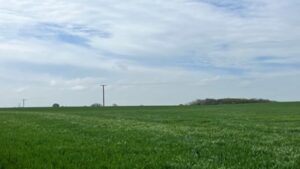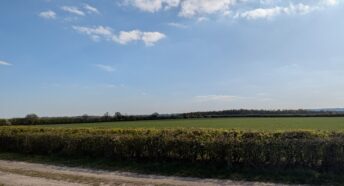Objection to a proposed solar farm in Bolsover
CPRE Derbyshire objects to the proposed solar farm installation on land to the south of Frithwood Farm Cottages and the north of Whaley Common.
Application details: Application Number 22/00583/FUL. Installation of ground mounted photovoltaic solar farm, sub-station and cameras and fencing. 45 Hectares and 25MW for supporting up to 7000 houses. Proposal to build on good quality arable land for 40 years. Grade 2 /3A and 3B land. No significant landscape features but good fertile land in the Limestone Farmlands of the Nottinghamshire /Yorkshire coal fields.
CPRE Derbyshire is realistic about the expansion of renewable energy generation as a critical part of delivering our net carbon neutral targets. We are supportive in principle of well-planned development of this nature that also accounts thoroughly for local needs.
In practice, however, we apply the same principles to evaluate the location, design and impact of such sites as to any other development taking place in the countryside, considering national and local planning policy.
Our primary focus and objective is to ensure that sensitive landscapes are protected from detrimental impacts of development and in line with the NPPF guidelines on sustainability, are preserved for both current and future generations from the perspective of distinctive landscape character assets as well as important access and amenity to cherished green spaces conveniently close to where people live.
The value of countryside to people’s wellbeing and as a buffer against climate change has never been more obvious, and its heritage value, once lost or seriously degraded, is virtually impossible to retrieve. Development proposals in open countryside or on undeveloped green field sites, we believe, must be considered holistically in terms of what these places mean to people and contribute to communities now and for the future.
CPRE’s stance on solar energy
CPRE, the countryside charity, is committed to supporting solar energy but will always oppose harmful developments. Solar photovoltaics are an important part of our energy supply in the climate emergency, but huge greenfield sites which damage our countryside ignore the huge potential of roof-mounted solar.
CPRE is a passionate advocate for climate action, and we have clearly stated our support for renewable energy, but the need for energy does not justify damaging developments. We support schemes that minimise landscape impacts, secure real nature recovery opportunities and enjoy the support of local communities. Schemes that fail to meet these expectations, like this one, must be refused.
Our objection
The location of choice for solar developments has become valuable farmland, ignoring the 250,000 hectares of south-facing commercial roof space (enough to meet half the UK’s electricity demand) not to mention domestic roofs and surface car parks that could be harnessed with little impact on landscape, tranquillity and cultural heritage. By enabling greenfield solar you are actively courting public opposition to solar energy and putting progress towards net zero at risk.

From CPRE Derbyshire’s perspective, there are three things which weight our views to objecting to this application.
Firstly, we are opposed to building solar farms on good farmland , which in our view should be best utilised for providing food security for this country. The applicant themselves have highlighted that this application is across category 2, 3a and 3b, land, which in our view should be utilised for growing crops or used as pastureland for dairy cattle. The Government’s position on large solar farms is that they should be built on brownfield first or on poor quality land not really fit for farming. We do not believe that there are sufficient “exceptional” circumstances to justify the building of this solar farm, which clearly goes against Bolsover Planning Policy on Renewable Energy “Policy SC6 Renewable and Low Carbon Energy
“Development proposals for the generation of renewable energy (except large wind turbines) will be granted unless either individually or cumulatively with other renewable energy development, there would be
a) Significant harm to the visual appearance and character of the area
b) Significant harm to the amenity of local residents, either individually or cumulatively with other renewable energy development particularly from noise, dust, odour, traffic or visual intrusion Proposals for large scale photovoltaic solar panels on Grades 1, 2 and 3a. Agricultural Land will only be permitted under exceptional circumstances.”

Secondly, the size of the proposed solar farm of 45 hectares, would significantly industrialise this very quiet and rural area and would have a significant impact on the landscape to both residents and users of the countryside in this area and of the Archaeological Way, which is becoming more of a tourist destination. If the development was a lot smaller and of similar size to other local approved solar farms in Bolsover (10 to 15 hectares), we would be more supportive.
Having visited the site, which is gently sloping, and fairly flat south of Frith Wood, we can see why the developers have chosen it, as it would be relatively cheap to install the equipment here, and it would not be highly visible to the majority of people living in the Bolsover area, but 45 hectares of photo voltaic solar panels in our view would be out of keeping with the rural setting and landscape of the area.
Thirdly, the proposed site for the solar farm is on the edge of a number of local conservation areas (five).
Bolsover Planning Policy SC16 Development Within or Impacting upon Conservation Areas states
“Development proposals within or impacting upon Conservation Areas will be permitted where they preserve or enhance the character and appearance of the area and its setting. Applications will be considered in relation to how well the design and location of the proposal has taken account of the development characteristics and context of the conservation area, in terms of open buildings and open spaces, landscapes, walls, trees and views into or out of the area the form, scale, size and massing of nearby buildings, together with materials for construction.
In addition, point 7.34 in the Bolsover Plan states;
“In the last few years, four sites have been granted planning permission, for solar photovoltaic farms on sites that range between 9 and 12 hectares. The Council will continue to support applications for large scale ground-mounted solar photovoltaic farms, on brownfield land or Grade 4 and 5 Agricultural land.”
We don’t believe that this development proposal is in keeping with the local Conservation areas.









